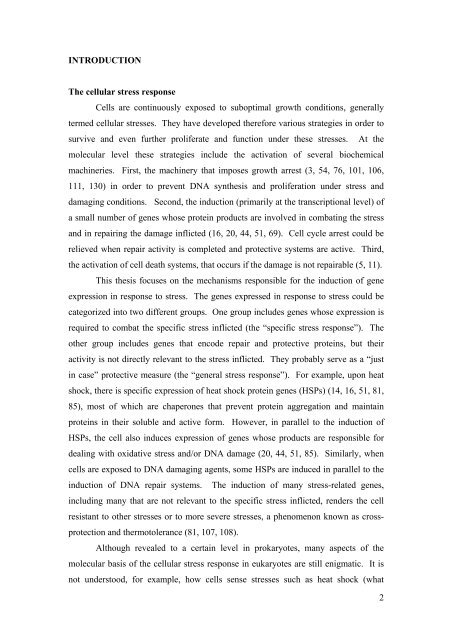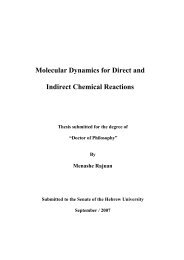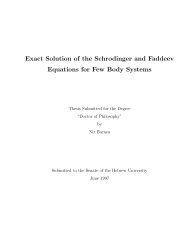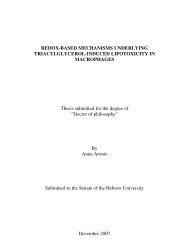Revealing the Mechanism of HSP104 Transcription Initiation in the ...
Revealing the Mechanism of HSP104 Transcription Initiation in the ...
Revealing the Mechanism of HSP104 Transcription Initiation in the ...
Create successful ePaper yourself
Turn your PDF publications into a flip-book with our unique Google optimized e-Paper software.
INTRODUCTION<br />
The cellular stress response<br />
Cells are cont<strong>in</strong>uously exposed to suboptimal growth conditions, generally<br />
termed cellular stresses. They have developed <strong>the</strong>refore various strategies <strong>in</strong> order to<br />
survive and even fur<strong>the</strong>r proliferate and function under <strong>the</strong>se stresses. At <strong>the</strong><br />
molecular level <strong>the</strong>se strategies <strong>in</strong>clude <strong>the</strong> activation <strong>of</strong> several biochemical<br />
mach<strong>in</strong>eries. First, <strong>the</strong> mach<strong>in</strong>ery that imposes growth arrest (3, 54, 76, 101, 106,<br />
111, 130) <strong>in</strong> order to prevent DNA syn<strong>the</strong>sis and proliferation under stress and<br />
damag<strong>in</strong>g conditions. Second, <strong>the</strong> <strong>in</strong>duction (primarily at <strong>the</strong> transcriptional level) <strong>of</strong><br />
a small number <strong>of</strong> genes whose prote<strong>in</strong> products are <strong>in</strong>volved <strong>in</strong> combat<strong>in</strong>g <strong>the</strong> stress<br />
and <strong>in</strong> repair<strong>in</strong>g <strong>the</strong> damage <strong>in</strong>flicted (16, 20, 44, 51, 69). Cell cycle arrest could be<br />
relieved when repair activity is completed and protective systems are active. Third,<br />
<strong>the</strong> activation <strong>of</strong> cell death systems, that occurs if <strong>the</strong> damage is not repairable (5, 11).<br />
This <strong>the</strong>sis focuses on <strong>the</strong> mechanisms responsible for <strong>the</strong> <strong>in</strong>duction <strong>of</strong> gene<br />
expression <strong>in</strong> response to stress. The genes expressed <strong>in</strong> response to stress could be<br />
categorized <strong>in</strong>to two different groups. One group <strong>in</strong>cludes genes whose expression is<br />
required to combat <strong>the</strong> specific stress <strong>in</strong>flicted (<strong>the</strong> “specific stress response”). The<br />
o<strong>the</strong>r group <strong>in</strong>cludes genes that encode repair and protective prote<strong>in</strong>s, but <strong>the</strong>ir<br />
activity is not directly relevant to <strong>the</strong> stress <strong>in</strong>flicted. They probably serve as a “just<br />
<strong>in</strong> case” protective measure (<strong>the</strong> “general stress response”). For example, upon heat<br />
shock, <strong>the</strong>re is specific expression <strong>of</strong> heat shock prote<strong>in</strong> genes (HSPs) (14, 16, 51, 81,<br />
85), most <strong>of</strong> which are chaperones that prevent prote<strong>in</strong> aggregation and ma<strong>in</strong>ta<strong>in</strong><br />
prote<strong>in</strong>s <strong>in</strong> <strong>the</strong>ir soluble and active form. However, <strong>in</strong> parallel to <strong>the</strong> <strong>in</strong>duction <strong>of</strong><br />
HSPs, <strong>the</strong> cell also <strong>in</strong>duces expression <strong>of</strong> genes whose products are responsible for<br />
deal<strong>in</strong>g with oxidative stress and/or DNA damage (20, 44, 51, 85). Similarly, when<br />
cells are exposed to DNA damag<strong>in</strong>g agents, some HSPs are <strong>in</strong>duced <strong>in</strong> parallel to <strong>the</strong><br />
<strong>in</strong>duction <strong>of</strong> DNA repair systems. The <strong>in</strong>duction <strong>of</strong> many stress-related genes,<br />
<strong>in</strong>clud<strong>in</strong>g many that are not relevant to <strong>the</strong> specific stress <strong>in</strong>flicted, renders <strong>the</strong> cell<br />
resistant to o<strong>the</strong>r stresses or to more severe stresses, a phenomenon known as crossprotection<br />
and <strong>the</strong>rmotolerance (81, 107, 108).<br />
Although revealed to a certa<strong>in</strong> level <strong>in</strong> prokaryotes, many aspects <strong>of</strong> <strong>the</strong><br />
molecular basis <strong>of</strong> <strong>the</strong> cellular stress response <strong>in</strong> eukaryotes are still enigmatic. It is<br />
not understood, for example, how cells sense stresses such as heat shock (what<br />
2
















